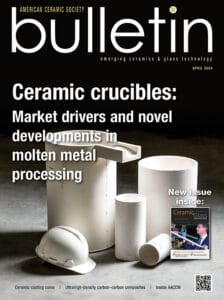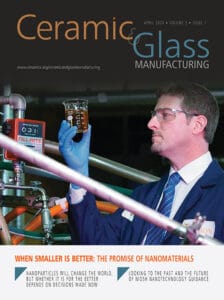ICACC ’23 Plenary Speaker
 Dr. Rita Baranwal is Chief Technology Officer at Westinghouse Electric Company. In this role, she leads the company’s global research and development investments and spearheads a technology strategy to advance the company’s innovative nuclear solutions. She brings nearly 25 years of experience to this role, which she has held since January 2022.
Dr. Rita Baranwal is Chief Technology Officer at Westinghouse Electric Company. In this role, she leads the company’s global research and development investments and spearheads a technology strategy to advance the company’s innovative nuclear solutions. She brings nearly 25 years of experience to this role, which she has held since January 2022.
This role marks a return for Rita to Westinghouse, where she worked for nearly a decade in senior leadership positions for the Global Technology Development, Fuel Engineering and Product Engineering groups.
During her career, Rita served as Assistant Secretary for Nuclear Energy in the U.S. Department of Energy (DOE) in a U.S. President-appointed and Senate-confirmed role. She led efforts to promote R&D on existing and advanced nuclear technologies that sustain the U.S. fleet of nuclear reactors and enable the deployment of advanced nuclear energy systems.
Rita also has held senior leadership roles with the Idaho National Laboratory as Director of the Gateway for Accelerated Innovation in Nuclear (GAIN) initiative and, most recently, the Electric Power Research Institute (EPRI) as Chief Nuclear Officer and Vice President of Nuclear. Earlier in her career, she led and conducted R&D in advanced nuclear fuel materials for U.S. Naval Reactors at Bechtel Bettis, Inc.
Rita holds advanced degrees in materials science and engineering, including a Ph.D. from the University of Michigan. She is distinguished as an American Nuclear Society Fellow.
Title: Westinghouse fuel innovation leveraging advanced ceramics
Abstract: Energy is central to nearly every major challenge and opportunity the world faces today. Over the next 20 years, the world population is expected to grow 25% and, by 2030, demand for electricity will nearly double. To meet the world population’s growing energy demands, Westinghouse is investing in advanced materials and reactors technologies that provide a carbon-free power grid that’s always on – here on earth and beyond. Westinghouse has established key reactor and fuel initiatives to support a clean energy future, many of which rely upon advanced ceramic materials. From nuclear fuel to moderators and instrumentation components, many of the technologies within our fuel innovation portfolio are ceramic-based materials.
The Westinghouse Encore Accident Tolerant Fuel ProgramTM is developing fuel technologies that provide enhanced safety margins in the event of a severe accident compared to conventional fuels. The program is comprised of both cladding and nuclear fuel pellet technologies. ADOPTTM fuel is a doped large grained UO2 based ceramic pellet, capable of delivering increased economic benefit and safety margin to customers through its higher density and reduced fission gas release. The ATF program also includes a revolutionary cladding design using a Siam SiC-SiC composite that provides improved safety margins during beyond design basis accidents. This technology has been developed through collaboration with General Atomics.
Uranium Nitride (UN) is a revolutionary ceramic fuel pellet within the Encore Fuel Program but also has recognized benefits in advanced reactor and space power markets. In current Light Water Reactors (LWRs), the high density and enhanced thermophysical properties of UN support improved fuel cycle economics and safety margins. UN is also a fuel of choice for advanced reactor applications and is the primary fuel for the Westinghouse Lead Fast Reactor. In non-terrestrial applications like nuclear space power, UN possesses a necessary advantage over other fuel materials due to high power density, high melting temperature, and high thermal conductivity.
Westinghouse’s eVinci™ microreactor design is being leveraged to support commercial, defense, research, marine, and space applications and ceramic materials are integral to its operation. This autonomous microreactor’s solid-state design takes passive safety to a new level, leveraging heat pipe technology as the ideal solution to remove all moving parts responsible for cooling the reactor. Beryllium Oxide and Yttrium Hydride are both advanced ceramics employed in the Westinghouse eVinciTM microreactor as moderating and reflecting components, as well as providing structural support in high-temperature environments.
Advanced ceramics also play a critical role in non-fuel technologies within Westinghouse. For example, the Westinghouse in-rod wireless sensor features a ceramic housing to protect and maintain instrumentation internals. The Westinghouse wireless sensor can provide on-line fuel measurements that not only improve fuel utilization but may expedite fuel licensing and qualification timelines through wireless, real-time, data acquisition.
*EnCore, AP1000, eVinci, and ADOPT are trademarks or registered trademarks of Westinghouse Electric Company LLC, its affiliates and/or its subsidiaries in the United States of America and may be registered in other countries throughout the world. SiGA is a registered trademark of General Atomics, its affiliates and/or its subsidiaries in the United States of America and may be registered in other countries throughout the world. All rights reserved. Unauthorized use is strictly prohibited. Other names may be trademarks of their respective owners. © 2022 Westinghouse Electric Company LLC. All Rights Reserved
Subscribe to Ceramic Tech Today

Don’t miss the latest ceramic and glass materials news. Receive the CTT newsletter to your email three times a week by subscribing at this link.
Subscribe to Ceramic & Glass Manufacturing Weekly

Don’t miss the latest ceramic and glass business news. Receive the C&GM Weekly newsletter to your email every Monday by subscribing at this link.


